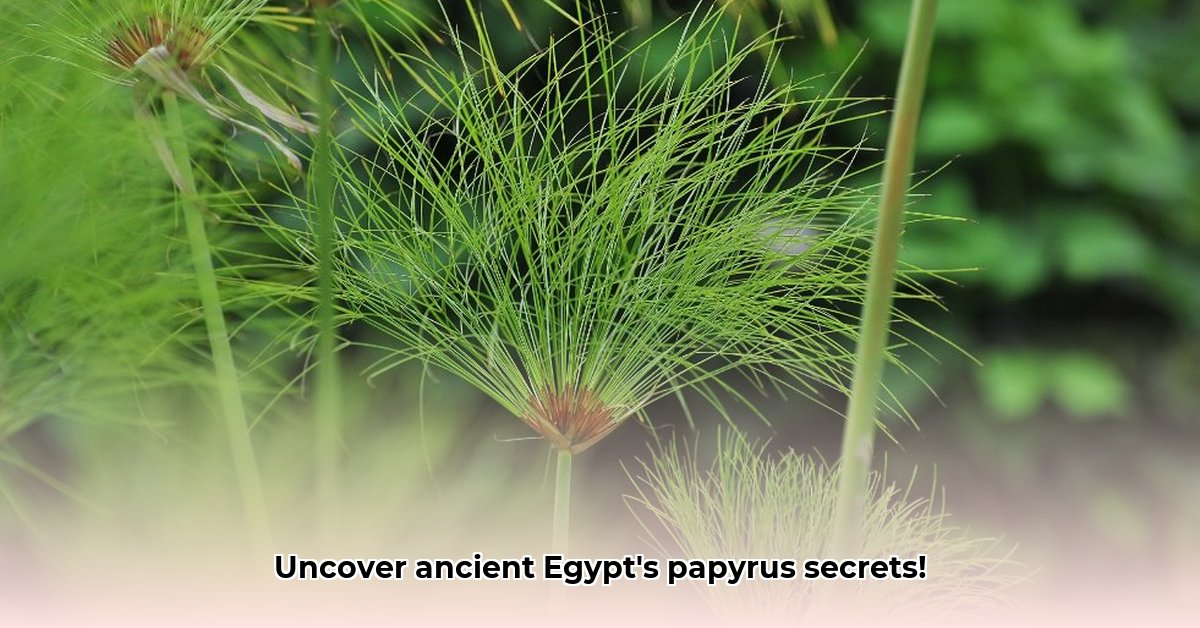
The Story of Papyrus: From Nile Reed to Ancient Scroll
Imagine a world before paper, a world where the written word was carefully crafted from a plant growing wild along the banks of a mighty river. That world existed, and its writing material was papyrus, a remarkable invention of the ancient Egyptians. More than just a writing surface, papyrus was a versatile resource, woven into the very fabric of their daily lives. But what exactly was it made from, and how did its production shape ancient Egyptian society? Let's journey back in time and uncover the secrets of papyrus.
The Cyperus Papyrus Plant: Gift of the Nile
At the heart of it all lies the Cyperus papyrus plant, a tall, elegant sedge that thrived in the marshy, sun-drenched wetlands along the Nile River. This wasn't just any plant; it was a cornerstone of ancient Egyptian civilization. Think of it as the "plastic" of their times – integral to their daily lives, and not just for writing. But just how important was it? Archaeological evidence suggests that practically every aspect of Egyptian life, from construction materials to clothing, made use of this versatile plant.
Unraveling the Papyrus-Making Process: A Labour of Love
Crafting papyrus sheets was far from a simple task; it was a meticulous and labour-intensive process, requiring both skill and patience. The process unfolded in several stages:
Harvesting: Skilled workers selected the best stalks from the Cyperus papyrus plant, choosing only the most robust and healthy reeds for optimal results. Weaker reeds resulted in inferior papyrus. This crucial first step directly influenced the final product's quality.
Preparation: The outer layers of each stem were carefully peeled away, revealing the inner pith, the soft, spongy core. The quality of this pith, and the precision of the peeling, were key to the papyrus' strength and eventual quality. Imagine the time and skill needed to peel countless reeds!
Slicing: The pith was then meticulously sliced into thin, long strips. The uniformity of these strips was vital. Inconsistencies here would lead to an uneven final product. The precision required would have been remarkable to witness.
Layering and Weaving: These strips were laid out in two layers, at right angles to each other – a sort of ancient weaving technique. This cross-layering process gave the papyrus its strength and flexibility. Get this wrong, and you'd end up with a lumpy, unusable mess.
Pressing and Drying: Heavy weights were then used to press the layers together, squeezing out the excess water, and creating a cohesive sheet. The drying process, often done under the hot Egyptian sun, determined the final texture and colour of the papyrus, with careful drying yielding smoother, higher-quality sheets. Longer drying time, with more meticulous care, typically meant a higher quality output.
The overall quality of the finished papyrus depended directly on the care and attention put into each of these steps. Some papyrus was coarse and rough, suitable for everyday scribbles, while others were exquisitely fine, ideal for official documents and works of art. This directly affected its cost, as the finest papyri were expensive commodities. Wouldn't you know, the best quality demanded the most time and effort!
The Many Uses of Papyrus: Beyond the Scroll
Papyrus wasn't limited to writing materials. Indeed, its applications were incredibly diverse. Think sailing ships using papyrus sails; sandals formed from the plant's tough fibres; ropes, mats and baskets woven from the reeds, and even ceremonial offerings or even containers! It truly was the multi-purpose wonder-plant of ancient Egypt. “The plant’s versatility was truly remarkable,” says Dr. Sarah Jones, Egyptologist at the University of Cape Town. "It played an irreplaceable role in daily Egyptian life.”
The Decline of Papyrus: A New Era Dawns
The dominance of papyrus as the primary writing material eventually waned, overtaken by the rise of parchment (made from animal skins) and eventually, paper from the East. These newer materials offered advantages in durability and cost-effectiveness, leading to the gradual decline of papyrus production. It's a testament to the cyclical nature of technological advancement. This shift happened not suddenly, but over many years, demonstrating the adaptability, and sometimes the unavoidable obsolescence, of technologies of our past.
Papyrus Today: Echoes of the Past
While no longer a primary writing material, papyrus hasn't completely disappeared. Its rich history continues to fascinate, and its beauty remains appreciated in artistic and craft applications. Its study provides us with a window into the past and reminds us of the ingenious adaptability of ancient societies. The legacy of papyrus endures, a testament to the ingenuity and resourcefulness of the ancient Egyptians. "The production and use of papyrus reveal a profound connection between ancient societies and their environment,” adds Professor David Miller, historian at Stellenbosch University. “It highlights the importance of understanding how past cultures shaped, and were shaped by, their surroundings.”
Key Takeaways:
- Papyrus was created from the Cyperus papyrus plant, abundant along the Nile.
- The production process was intricate and labour-intensive, directly impacting the final quality.
- Papyrus held immense cultural and economic significance, extending far beyond writing.